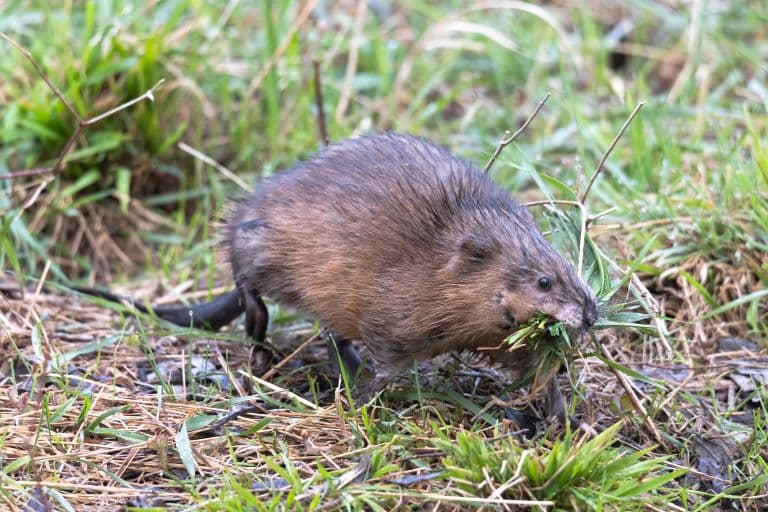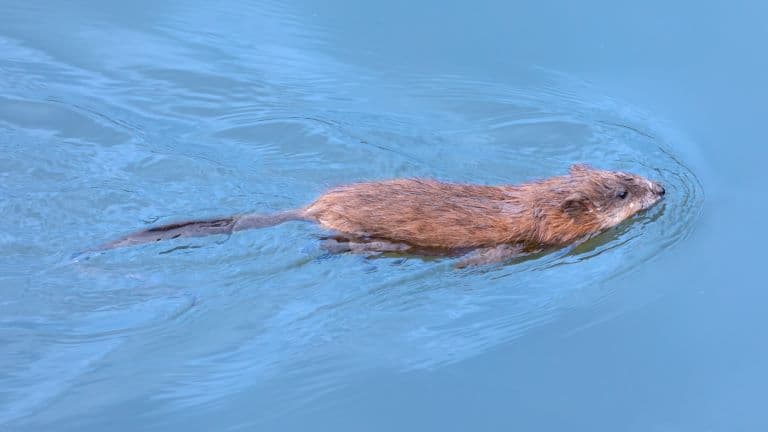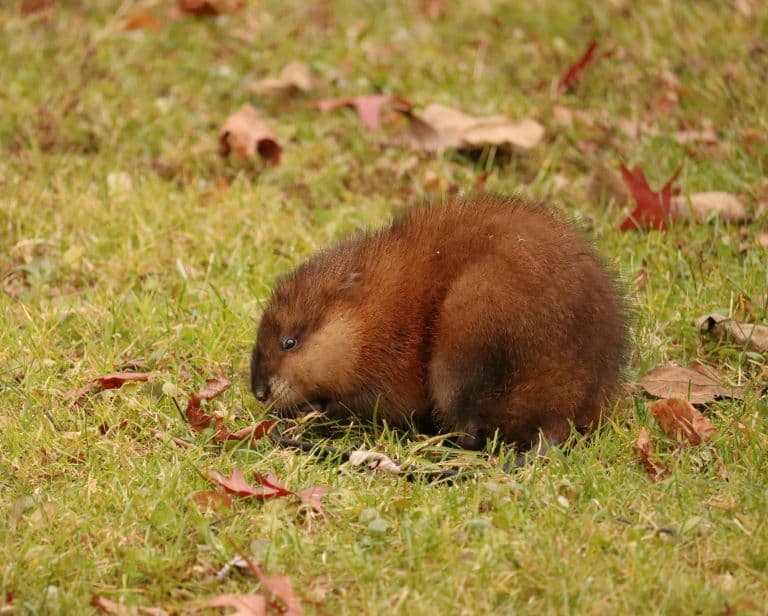Muskrat Profile
Rodents are the most diverse order of mammals and live all over the world in various shapes and forms. There are so many, it’s easy to overlook a few of them.
But the muskrat is a force of nature with a long history of human interaction, yet they are rarely considered by people outside of the context of either pests or the fur trade.
And that’s a pity because as the largest member of the hamster family, they have a huge impact on their environment.

Muskrat Facts Overview
| Habitat: | Semi aquatic, wetland habitats |
| Location: | Europe, Asia, and South America |
| Lifespan: | 3 in the wild, 10 in captivity |
| Size: | 70 cm (28 inches) |
| Weight: | Up to 2k (4.5lb) |
| Colour: | Brown, beaver-colour |
| Diet: | Mostly aquatic plants like cattail and water lillies, some animals |
| Predators: | Alligators |
| Top Speed: | Slow, but nimble underwater |
| No. of Species: | 1 |
| Conservation Status: | Least Concern (IUCN) |
Muskrats aren’t true rats, but from a separate family of rodents that includes lemmings, hamsters and voles. They’re wetland specialists, spending much of their time in water, and named after their special scent.
These are highly successful rodents, doing great work in their native lands and destroying lots of places they’ve been introduced to. But in the regions where they belong, they create and maintain ecosystems for multitudes of plants and wildlife.
Interesting Muskrat Facts
1. They’re not really rats
Muskrats are certainly rodents, and large ones, at that. They somewhat resemble beavers and this makes sense because they’re also semi-aquatic, but they’re closer related to voles, hamsters and lemmings, with whom they share a family.
They’re the largest of this family, and around four times the weight of a brown rat, but still significantly smaller than a beaver.

2. But they are musky
The musk part of their name refers to the musky odour which they use to mark their territory, and the species name, zibethicus refers to this, too.
Not only is this musk used to paint a territorial boundary, but it’s also a way for individuals to communicate with one another.
But they also talk quite a bit and can be heard squeaking and squealing as needed. Ironically, the muskrat’s sense of smell isn’t all that good. Probably for the best.
3. They’re good in cold water
What is good, however, is their adaptation to their aquatic environments. Muskrats are often immersed entirely in cold water, and so they’ve grown some pretty nifty characteristics to deal with it.
Their fur is thick, dark, and double-coated which makes them more or less waterproof. Their tails have no fur at all, and instead are scaled and flattened to be used as a paddle or rudder. Their large hind feet are partially webbed and used similarly.
They can stay underwater for around 20 minutes at a time and are less sensitive to CO2 build-up than most mammals.
Finally, their lips close behind their huge incisors, as you find in mole rats and beavers, and for a similar reason: so they don’t get dirt/water in their mouths when digging and swimming at the same time. And these rodents love to dig! 1

4. They’re good architects
These rodents make special burrows that open out above the level of the river bank. But they’re not accessed from the outside; instead, they have entry chambers and tunnels that can only be accessed from underwater.
Different structures are used for different things – some for feeding, some for nesting, and they’re dug up to seven meters into the bank of the river. 2
5. They’re battle-hardened
Muskrats are tough dudes. These territorial rodents pair up and then have to defend their plot from encroaching competitors. And they do this with surprising ferocity; many adults die or are severely injured this fights that occur between rivals.
Successful warriors will build nests and breed and form large family groups to fill out their territories. But if these groups get too big, the old females will kick their offspring out of the group to make room.
In some very crowded conditions, they resort to cannibalism. 3
6. And ecosystem engineers
In snowy regions, muskrats build structures called push-ups which are used as shelter for resting and eating. They’re mounds of pushed-up snow and dirt and can be seen dotted about on frozen lakes.
They also build eating platforms on the water that are built out of cut vegetation held together with branches. This essentially maintains the marshland by keeping plant growth down and makes the muskrat a designer of its own habitat, as well as that of all the animals and plants who share it.

7. They’re a family food
There’s a long history of people eating these rodents in North America. In Michigan, the Catholics have it written into a dispensation that they can eat muskrats around the table on a few special occasions.
In 2019 there was a muskrat bonanza for Lent along the Detroit River, during which time 900 muskrats were consumed in a single mealtime.
But the human history with this animal goes much further back than that. The 20th Century saw an entire fur industry built around this animal, and the native populations have hunted them for fur and meat for thousands of years.
Their dense fur made them popular around the 1900s and were sold as seal fur to unsuspecting Europeans. And they were even introduced to Europe with disastrous consequences. 4 5
8. But they can be devastating
The burrowing nature of this animal makes it damaging to certain human structures like dykes and dams. In places where they’ve been introduced, some populations have become invasive, and are causing significant problems to the local area.
They also damage crops, eating grains but also plugging drainpipes and affecting irrigation.
So, their biggest enemy is the local human population. They’re still trapped extensively for their fur, and in places where they’re a pest, they’re killed as such. But this is a resilient animal and the population is still robust enough to be of no conservation concern.
Muskrat Fact-File Summary
Scientific Classification
| Kingdom: | Animalia |
| Phylum: | Chordata |
| Class: | Mammalia |
| Order: | Rodentia |
| Family: | Cricetidae |
| Genus: | Ondatra |
| Species: | zibethicus |
Fact Sources & References
- “muskrat”, Britannica.
- “Common Muskrat”, IUCN Red List.
- “Ondatra zibethicus muskrat”, Animal Diversity Web.
- Leyland DeVito (2017), “Muskrat Dinners a Tradition During Lent Downriver”, Hour Detroit.
- “Ondatra zibethicus muskrat”, Animal Diversity Web.
